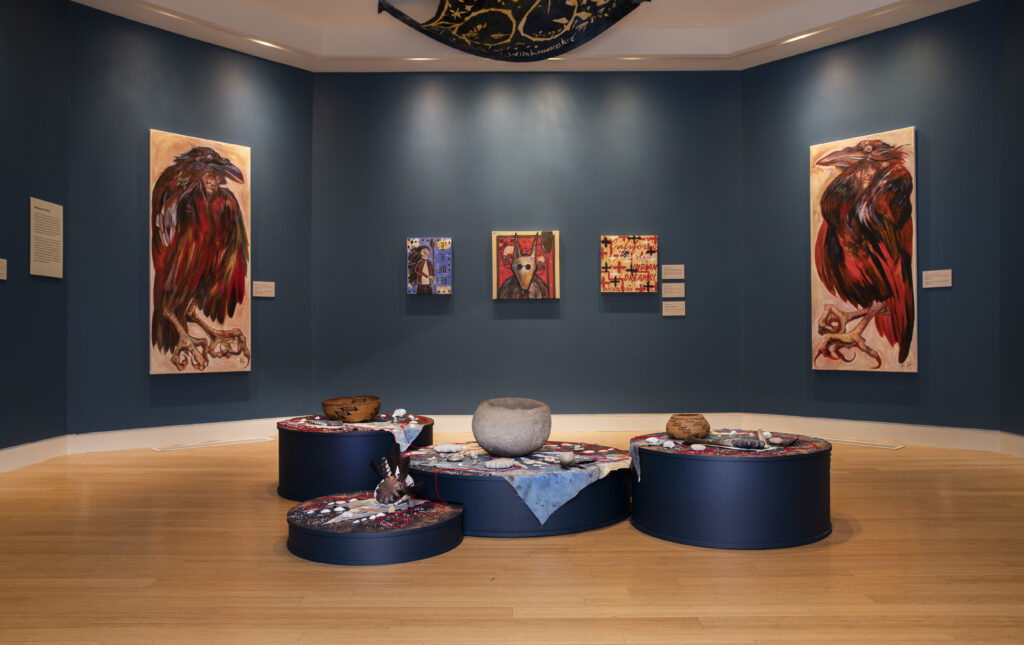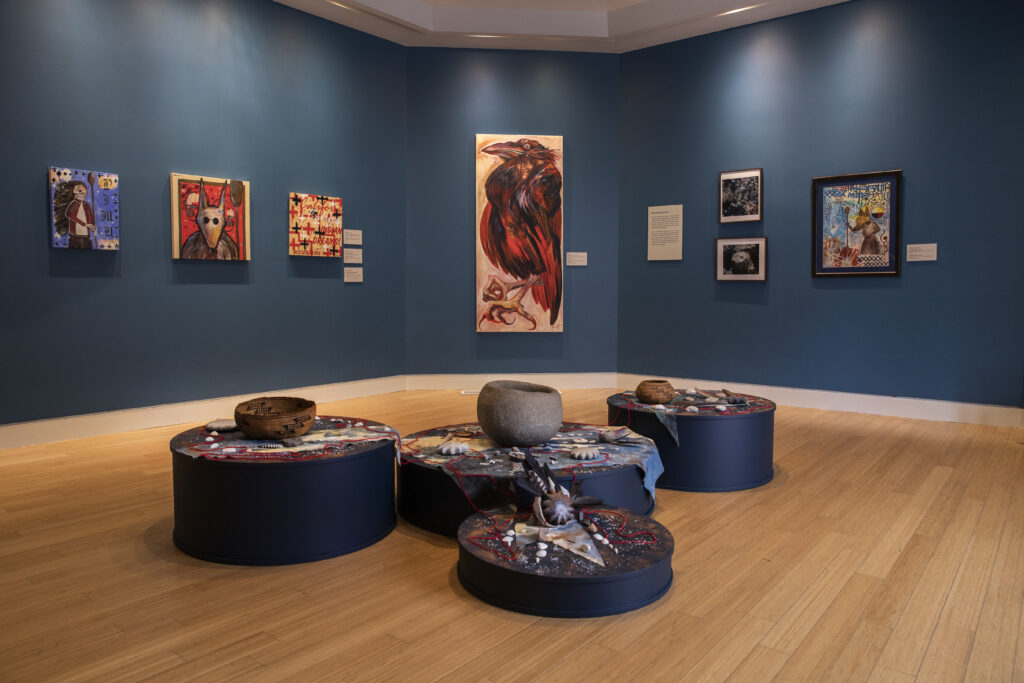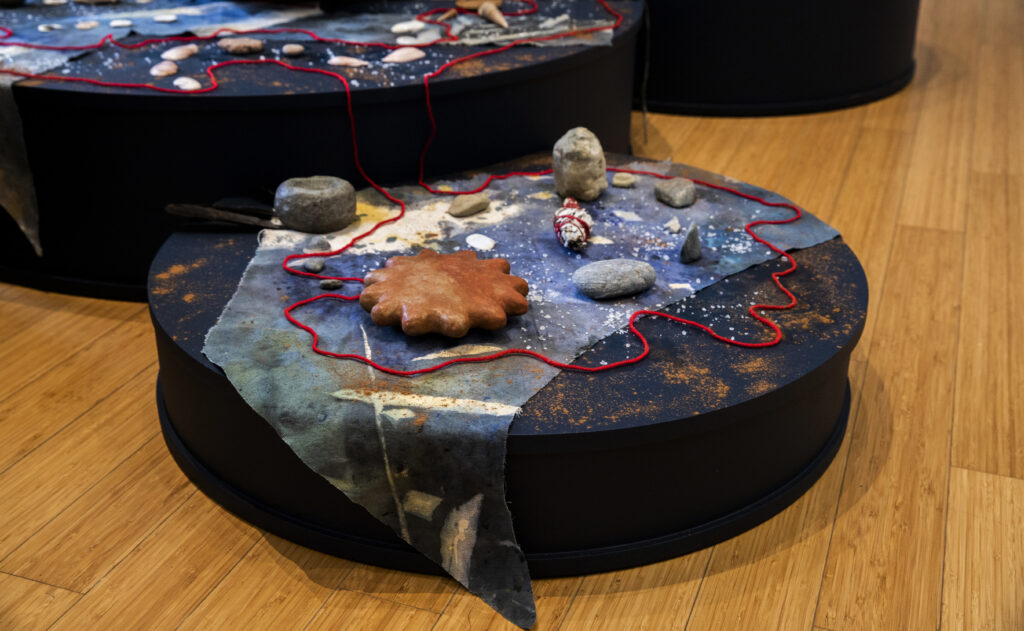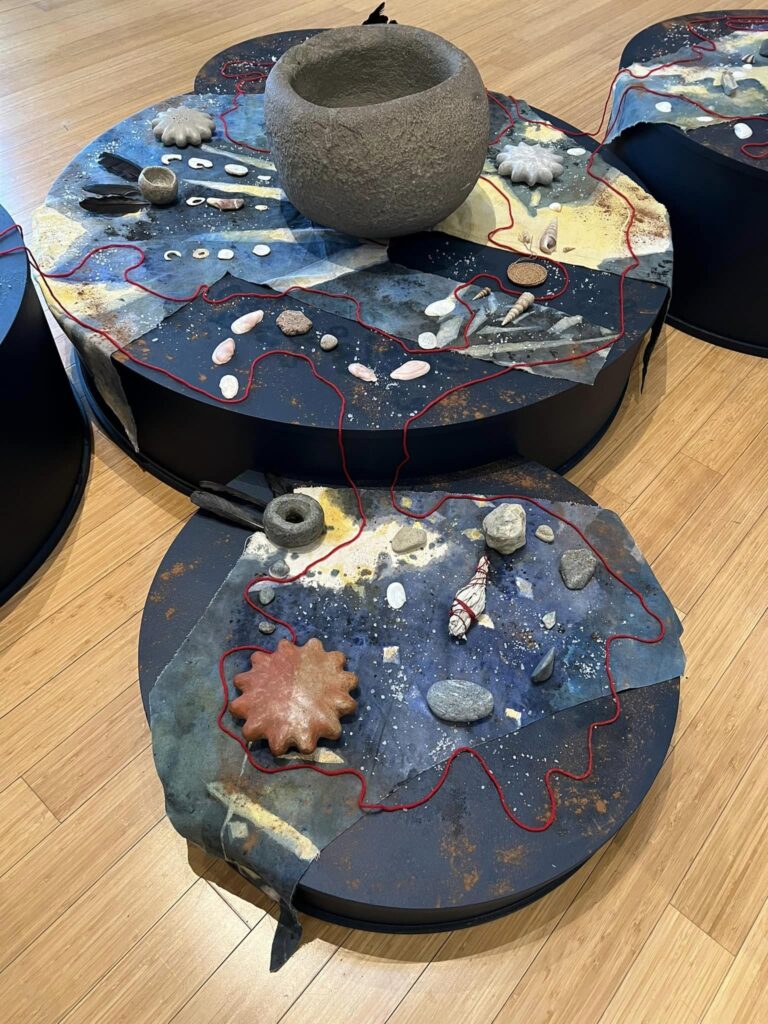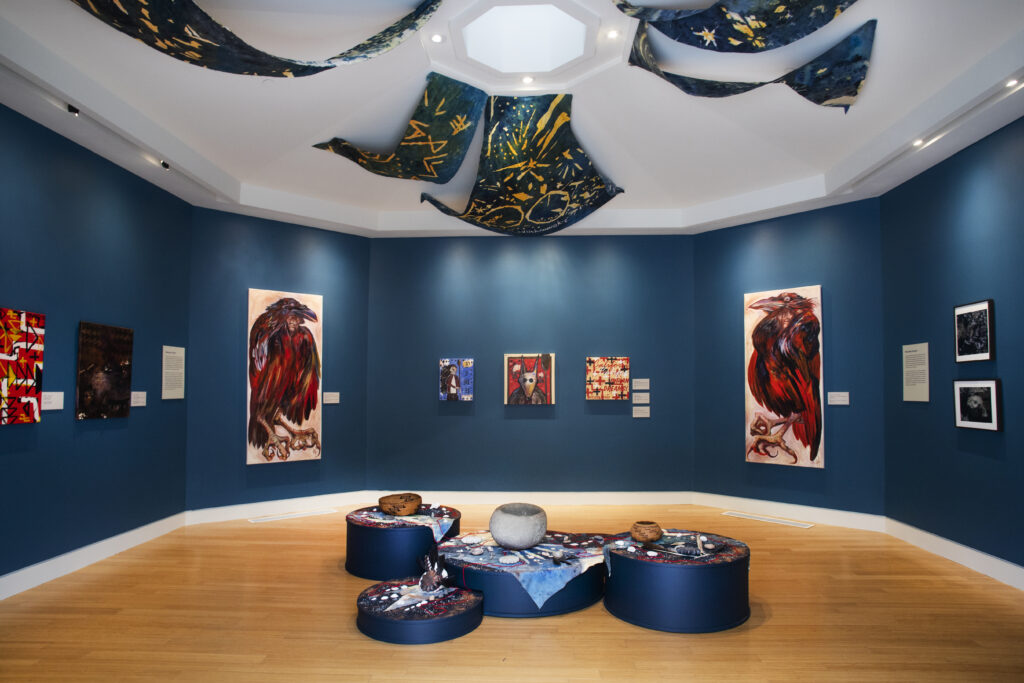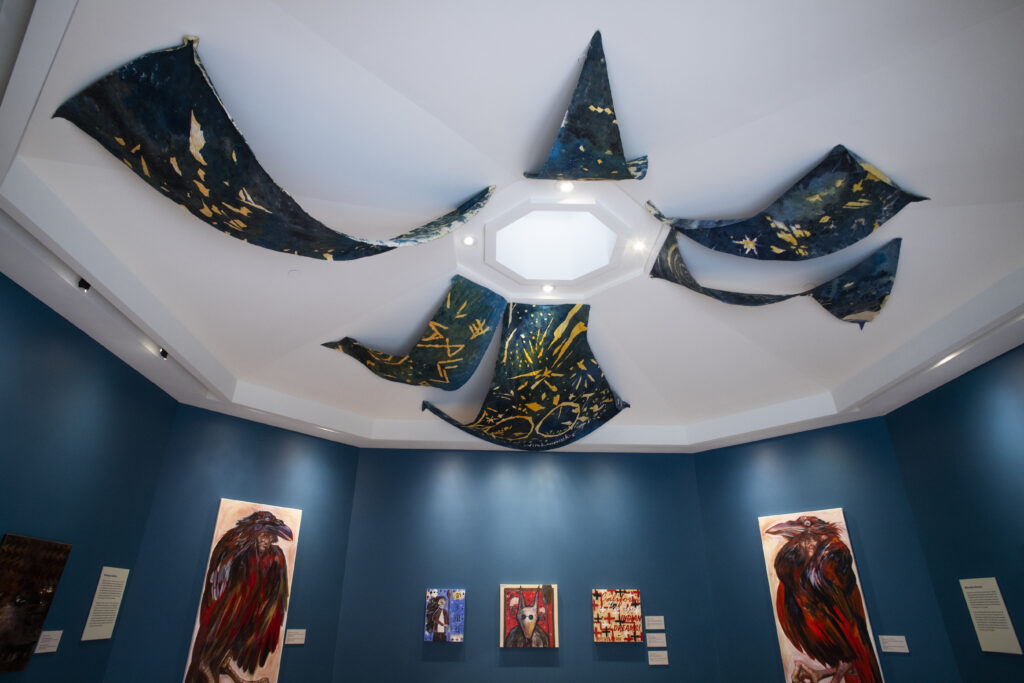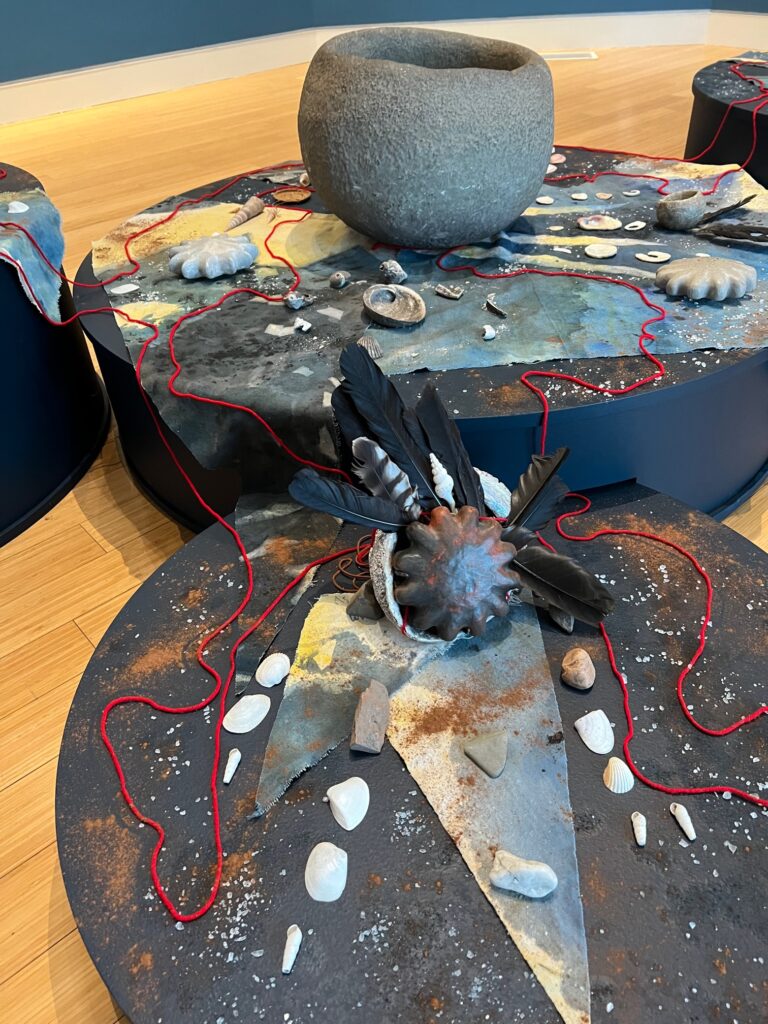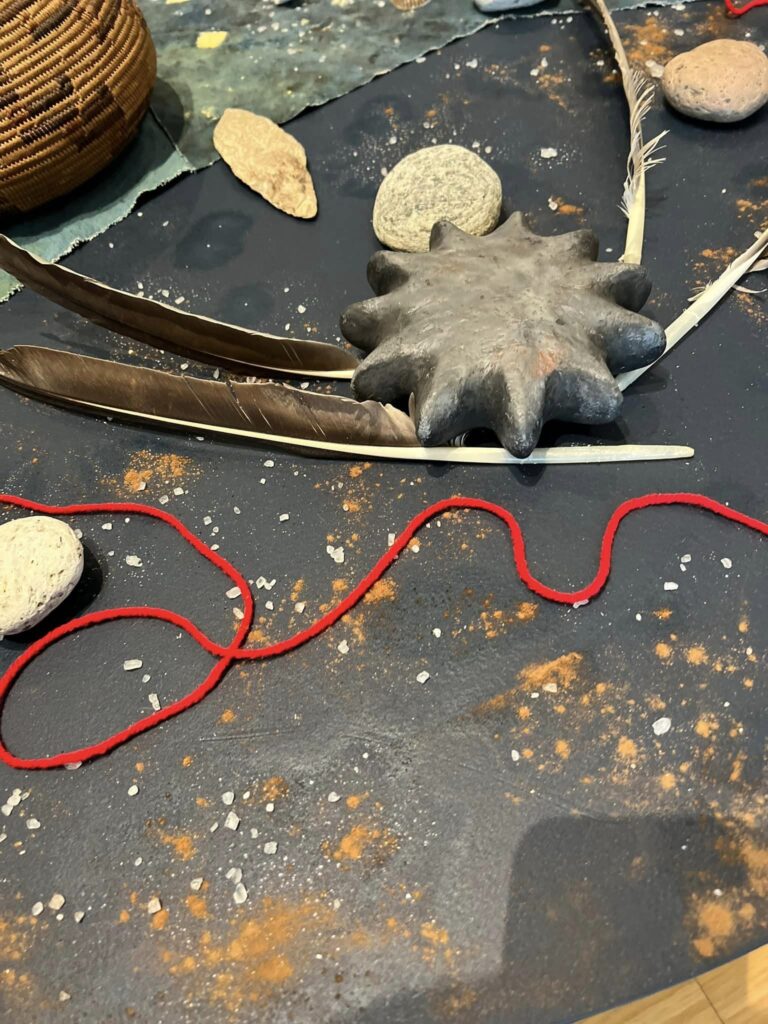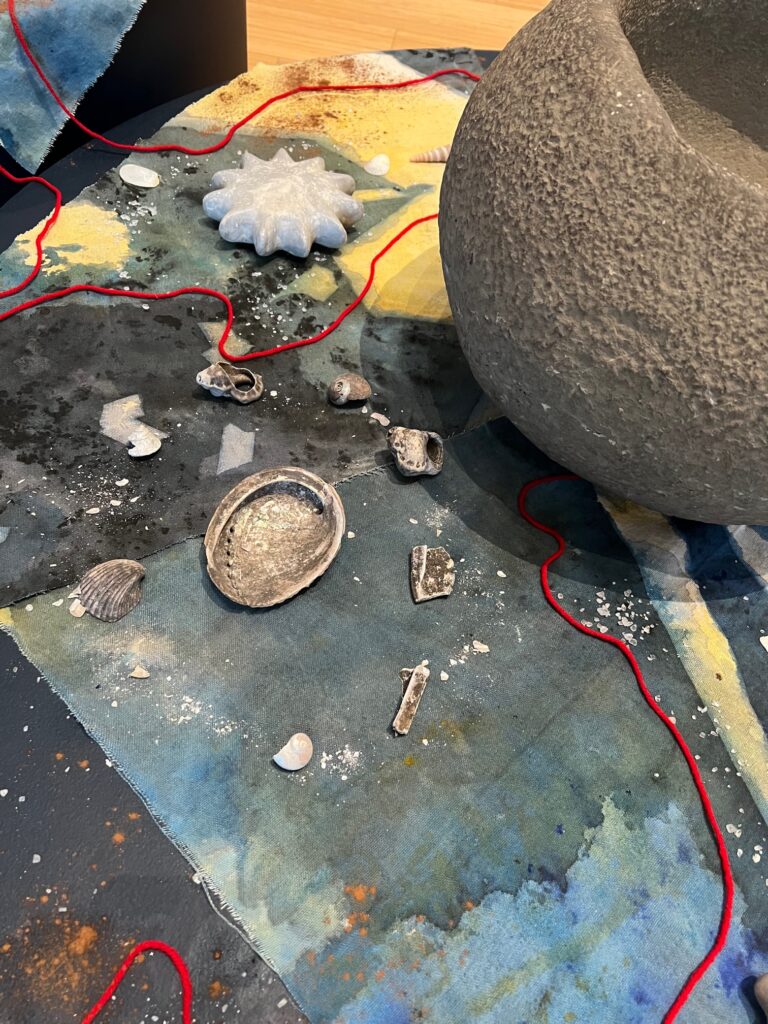Crossing Waters: Contemporary Tongva Artists Carrying Pimugna, now at the Catalina Museum for Art and History in Avalon, is an exhibition filled with awe and wonder, exploring a rich cultural heritage too long unseen.
The art is a beautiful expression of the placement and interconnectedness of Pimugna, and its relationship to the greater world of Tovaangar and its people, the Tongva, as viewed through the alchemic lens of three contemporary Tongva artists.
First some background: Tovaangar is the Tongva name for whole or middle world – land, water, and the Original People. That world includes the Southern Channel Islands, including the island of Pimugna, often shortened to Pimu, or as you may commonly know it, Catalina Island. The islands, separated by the sea from each other and from the mainland are yet connected to both through paths on the water, with the underlying message being that the world and its people exist, and are still here.
The art in this exhibition has a rich palette of blues, reds, blacks, and browns. The walls themselves are painted blue, allowing a sense of immersion to occur almost immediately. It is as if one has taken a dive into the deep blue sea of the Tovaangar. The exhibiting three artists, Weshoyot Alvitre, Mercedes Dorame, and River Garza have created a stellar beginning to a partnership between the Catalina Museum of Art and History and the Tongva Community, recognizing the Tongva people as the first islanders of Santa Catalina. Creating the exhibit, under the auspices of the museum’s deputy director and chief curator Johnny Sampson, the artists had not worked together previously, but have nonetheless formed a cohesive, and highly spiritual body of work that dances with light and magic.
In the center of the semi-circular exhibition space, Dorame’s site specific installation “We Dance Across the Water – Yakeenaxre Naamkomokre Paar, 2022,” grabs the viewer’s attention upon entering the gallery space.
The installation rests on a series of six platforms that seem to hover above the floor. On the ceiling above it, surrounding a small skylight with a view of the clouds and sky, are a series of acrylic on canvas paintings that depict stars, islands, and other petroglyph-like patterns. They are suspended so that they billow outward, like sails on the ships carrying the Original People between the islands.
Sections of the same canvas materials, with less specific patterns, are spread across the low platforms aligned on the floor. On these platforms rest a variety of beautiful objects, as well as cinnamon – standing in as a substitute for the ochre with which the Tongva people created art works in earlier times; salt crystals – which are allowed to congeal and come apart again, forming new crystal patterns, and which here remind the viewer of fallen stars or snow flakes; and patterns created in red thread that serve as maps connecting the world of the past with today’s world.
There are also feathers, shells, stones, and a series of steatite carved objects from the museum’s collection, woven baskets from the museum’s collection, the artist’s cast- concrete star stones, abalone, and personal items from artists Weshoyot Alvitre and River Garza.
Dorame’s patterned pathways and billowing sails reveal the intricate pathways and knowledge of her Tongva ancestors, guided by the sky, the sea, and a knowledge of nature and spiritual life infinite and profound.
On the wall positioned to either side of Dorame’s installation, hang a galvanizing series of works by Weshoyot Alvitre, “Hi mo-yok’ mok: po-koo (No, He is not dead: #1 – #4).” The two acrylic on canvas works, #1 and #2, depict a man within a bird’s brilliantly red body. #3 and #4 are ink on board, black and white with an ochre-like circular halo of sorts behind the head of the birdman. The story behind these works refers to an incident that occurred in the 16th Century. Two large crows, alighted on rocks, having flown from a patio where sacred rituals were performed, were shot by soldiers for Spanish missionary Father Antonio de la Ascension. The birds were killed, and the people mourned them. These works are a response to that carnage and to the sacred nature of the birds that had rested on the patio. The artist focuses on a reinterpretation of this traditional western-culture narrative, successfully resurrecting and representing her heritage, and that heritage’s role in the present and future as well.
River Garza gives us the trickster and protector – Coyote, who fills both roles. His acrylic, marker, and spray paint “Coyote in Red” wears dark glasses and carries one paddle; the mixed media color pencil, paint, and marker drawing “Coyote Paddles” also explores the artist’s connection to Tongva seafaring culture, as does his human “Paddler with Hair Blowing the Wind,” and both his “Untitled (CA Indian Dreams), and “Red Basket” acrylic works, which evoke the patterns on heirloom woven baskets. The artist’s “Mo’omat (Ocean),” combines a thick and deep brown and black acrylic paint with elements of dentalium, abalone, mother of pearl, olivella shells. Here, the viewer also finds a woven pattern, as well as a face, as compelling as it is mysterious and fierce. Three smaller figures and a document regarding a voyage are a part of this stunning, layered piece. In each work, Garva uses his ancestral history and iconography, combining both with the contemporary in a recreation and preservation of the Tongva past.
Above, entrance to the exhibition; Deputy Director of External Affairs Gail Fornasiere and Deputy Director / Chief Curator Johnny Sampson
Together, artists and curator have shaped a beautiful, welcoming, and revitalizing series of images that speak to the epic past of the Tongva, respect for history of the native peoples, and the spiritual, cultural, and creative through line of Pimu. It is an exhibition of grace and wonder, of which the Catalina Museum for Art and History can be proud. Expect to see more exhibitions relating to Tongva culture and island history in the future.
Next Friday, March 3rd, the exhibition will be featured in the museum’s First Fridays presentation, Culture between Cocktails. From 5-7 pm the museum offers light bites and drinks while guests enjoy one of the last opportunities to view the Crossing Waters: Contemporary Tongva Artists Carrying Pimugna. The free event requires advance registration; a specialty cocktail, wine, beer and other beverages are available for purchase.
To visit the museum, you’ll want to catch one of the comfortable, fast Catalina Express Boats from Long Beach, San Pedro, or Newport Beach. For an even more relaxing experience, you can upgrade and enjoy a beverage and snack in the spacious Commodore Lounge. It takes approximately one pleasant hour to reach the island from the mainland; the museum is just a short and lovely stroll from the docks. Getting there to see this stellar exhibition isn’t just simple – it’s fun.
- Genie Davis; Photos by Genie Davis and provided by the museum from James Kao Foto



